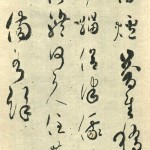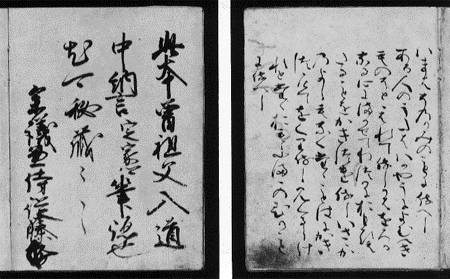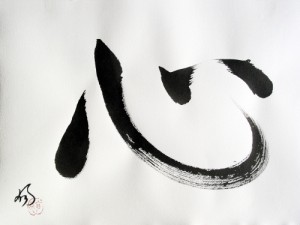Japanese Calligraphy Posted by Ginny on Mar 22, 2010 in Culture
Early Japanese calligraphy was first influenced by Chinese calligraphy. The piece of writing on the left is titled がっきろん (楽毅論) and was produced by Empress Kōmyō (光明皇后). The Empress copied this text from the Chinese calligrapher Wang Xizhi. All the original works done by Wang Xizhi have been lost, so the only copy of this form of calligraphy still left to us is Empress Kōmyō’s がっきろん.
 This piece is called, “Cry for Noble Saichō” (哭最澄上人) by Emperor Saga (嵯峨天皇). In contrast to the writing above, the characters are more rounded and less sharp. The characters are also less compact than the characters in the piece, がっきろん. In the late Heian era (平安時代), calligraphers began to slowly break away from Chinese influences to develop a unique Japanese style of calligraphy.
This piece is called, “Cry for Noble Saichō” (哭最澄上人) by Emperor Saga (嵯峨天皇). In contrast to the writing above, the characters are more rounded and less sharp. The characters are also less compact than the characters in the piece, がっきろん. In the late Heian era (平安時代), calligraphers began to slowly break away from Chinese influences to develop a unique Japanese style of calligraphy.
 This is an excerpt from a collection of poems called, きんだいしゅうか or “Superior Poems of Our Time”. The author’s name is Fujiwara no Teika (藤原定家). By the time of the Kamakura period (鎌倉時代) (1185-1333 AD) and the Muromachi period (室町時代) (1333-1573) Japanese calligraphy became more restrained, but yet retaining the innovative cursive style started in the Heian period.
This is an excerpt from a collection of poems called, きんだいしゅうか or “Superior Poems of Our Time”. The author’s name is Fujiwara no Teika (藤原定家). By the time of the Kamakura period (鎌倉時代) (1185-1333 AD) and the Muromachi period (室町時代) (1333-1573) Japanese calligraphy became more restrained, but yet retaining the innovative cursive style started in the Heian period.
 Japanese calligraphy has been affected by Zen Buddhism. Zen calligraphy tends to be very minimalist, with an emphasis on singular characters or phrases. The strokes tend to be dark, heavy and broad. Zen calligraphy is a spiritual experience for some calligraphers. The calligrapher is expected to put all his/her concentration in the strokes with fluid movments of the brush.
Japanese calligraphy has been affected by Zen Buddhism. Zen calligraphy tends to be very minimalist, with an emphasis on singular characters or phrases. The strokes tend to be dark, heavy and broad. Zen calligraphy is a spiritual experience for some calligraphers. The calligrapher is expected to put all his/her concentration in the strokes with fluid movments of the brush.
There are of course, many more styles of calligraphy not mentioned here. The point of this post was to show how Japanese calligraphy can be beautiful, technical, and various in form.

Build vocabulary, practice pronunciation, and more with Transparent Language Online. Available anytime, anywhere, on any device.



